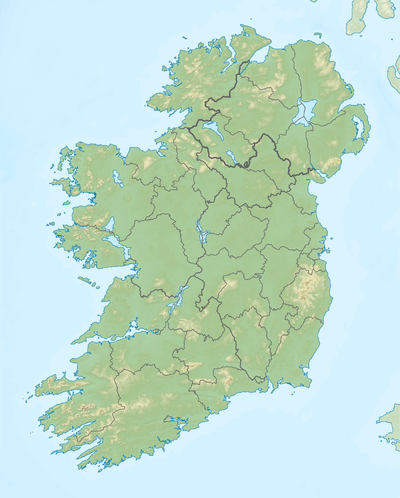Book of Lismore

| Book of Lismore | |
|---|---|
| Also known as | The Book of Mac Cárthaigh Riabhach |
| Date | 1408–11 |
| Place of origin | Duniry |
| Language(s) | Early Modern Irish |
| Scribe(s) | Aonghas Ó Callanáin |
| Material | Vellum |
| Size | 37cm x 25.5cm |
| Format | Folio |
| Condition | acephalous (missing 42 folios) and lacunose |
| Script | Irish minuscule |

The Book of Lismore is a Medieval Irish manuscript. It was so named by Dennis O'Flynn, a historian in Cork, to whom it had been given in 1815.[1] Eugene O'Curry blamed O'Flynn, in 1855, for splitting the book into parts and selling them off separately to collectors.[2]
Overview
The Book of Lismore is an Irish vellum manuscript, compiled in early 15th century, Lismore, Ireland. Its original name was Leabhar Mhic Cárthaigh Riabhaigh (The Book of Mac Cárthaigh Riabhach). It should not be confused with the similarly named Book of the Dean of Lismore, a Scottish manuscript from the 16th century. It was commissioned by Finghin MacCarthy Reagh, 8th Prince of Carbery and his wife Lady Catherine, daughter of Thomas FitzGerald, 7th Earl of Desmond.
The manuscript was compiled from the early, and lost, Book of Monasterboice as well as other manuscripts. The Book of Lismore contains a variation of themes. Part of the book references the lives of Irish saints, notably, St Brigid, St Patrick, and St Columba. The Book of Lismore also contains Acallam na Senórach, a most important Middle Irish narrative dating to the 12th century, a text pertaining to the Fenian Cycle.
The book also contains Leabhar Ser Marco Polo, an Irish translation of The Book of Sir Marco Polo, or Il Milione.
Some ninety per cent of the script is by an unknown scribe. About twelve folios were by Aonghas Ó Callanáin (fl. 15th century) who was from a local medical family. Some other brief insertions were also by unknown hands.
Some of the pages and text of the book became mislaid to scholarly pursuit soon after its discovery in 1814, but it is believed that copies of these pages still survive in scholarly articles written in the 19th century.
Texts
- Hagiographic texts
- Betha Shenáin meic Geirginn
- Short text on Saint Molaise, called "Molaisse und seine Schwester"
- Prose narratives
- Acallam Bec ("Little Colloquy")
- Echtra Loegairi meic Crimthainn from the Book of Lismore, at Thesaurus Linguae Hibernicae
- Airne Fíngein. Available at Thesaurus Linguae Hibernicae
- Tromdám Guaire ("The company of Guaire")
Translations from European Latin texts;
- Leabhar Ser Marco Polo ("The Book of Sir Marco Polo"), a translation in Irish of the Latin version of Marco Polo's Il Milione
- Gabháltas Séarlais Mhóir ("The Conquest of Charlemagne")
- Stair na Lombardach ("The History of the Lombards")
References
General
- Stokes, Whitley (ed. and tr.). Lives of saints, from the Book of Lismore. Oxford: Clarendon Press, 1890. Scans (PDF) available from the Internet Archive and a transcription of the edition from CELT.
Specific
- 1 2 O'Curry 1861, p. 196.
- ↑ O'Curry 1861, p. 199.
Bibliography
- O'Curry, Eugene (1861). "Of the Chief Existing Ancient Books". Lectures on the Manuscript Materials of Ancient Irish History: Delivered at the Catholic University of Ireland, During the Sessions of 1855 and 1856. Dublin: James Duffy.
Further reading
- Breatnach, Caoimhín. "Lismore, Book of." In Medieval Ireland: An Encyclopedia, ed. Seán Duffy. New York and London: Routledge, 2005. pp. 270–80.
- Macalister, R.A.S. The Book of Lismore. Facsimile with introduction. Dublin: Irish Manuscripts Commission, 1950. Facsimile edition.
- Ó Cuív, Brian (1983). "Observations on the Book of Lismore". Proceedings of the Royal Irish Academy. 83C: 269–292.
- Ó Murchadha, Family Names of County Cork. Cork: The Collins Press. 2nd edition, 1996. p. 54
External links
- http://www.irishtimes.com/newspaper/features/2011/0708/1224300294060.html
- http://www.maryjones.us/jce/lismore.html
- http://lismoreheritagecentre.blogspot.com/2010/02/book-of-lismore-introduction-by-donald.html
- http://www.medievalarchives.com/tag/book-of-lismore